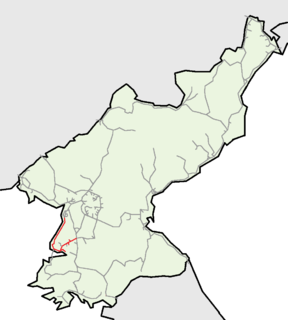
The Gyeongin Line (Gyeonginseon) is a railway mainline in South Korea, currently connecting Guro Station in Seoul and Incheon. Commuter services along the line through operates into Seoul Subway Line 1.
Sungri Motor Plant is a 600,000 m2 vehicle factory in the city of Tokchon (덕천), North Korea. It was the most capable plant of the North Korean automotive industry before being surpassed by Pyeonghwa Motors. The plant produces urban and off-road passenger cars, small, medium, and heavy cargo, as well as, haulage construction and off-road trucks and buses.

Tŏkch'ŏn is a si, or city, in northern South P'yŏngan province, North Korea. It is bordered by Nyŏngwŏn and Maengsan to the east, Kujang county in North P'yŏngan province to the north, Kaech'ŏn to the west and Pukch'ang to the south. It was known as "Tokugawa" during Japanese rule.

The Gyeongwon Line is a railway line serving northeastern Gyeonggi Province in South Korea. The line is operated by Korail. The name of the line came from Gyeongseong (Seoul) and Wonsan, the original terminus of the line, in what is now North Korea.
25 kV alternating current electrification is commonly used in railway electrification systems worldwide, especially for high-speed rail.

The P'yŏngnam Line is an electrified standard-gauge trunk line of the Korean State Railway in North Korea, linking P'yŏngyang with the port city of Namp'o and the hot springs at P'yŏngnam Onch'ŏn. The length of the line is 89.9 km (55.9 mi).
The automotive industry in North Korea is a branch of the national economy, with much-lower production than that in South Korea. North Korean motor vehicle production is geared towards the Korean People's Army, industrial and construction goals; there is little car ownership by private citizens. In addition to cars and trucks, North Korea produces buses, trolleybuses and trams.

The P'yŏngdŏk Line is an electrified standard-gauge trunk line of the Korean State Railway in North Korea running from Taedonggang Station in P'yŏngyang, where it connects to the P'yŏngbu, P'yŏngnam, P'yŏngra and P'yŏngŭi Lines, to Kujang, where it connects to the Manp'o and Ch'ŏngnyŏn P'arwŏn Lines. The total length of the line is 192.3 km (119.5 mi).

The Sinhŭng Line is an electrified 762 mm narrow gauge railway line of the Korean State Railway in South Hamgyŏng Province, North Korea, running from Hamhŭng (Hamhŭng-si) to Pujŏnhoban (Pujŏn-gun) on Lake Pujŏn via Sinhŭng (Sinhŭng-gun).

The Kangwŏn Line is a 145.8 km (90.6 mi) electrified standard-gauge trunk line of the Korean State Railway of North Korea, connecting Kowŏn on the P'yŏngra Line to P'yŏnggang, providing an east–west connection between the P'yŏngra and Ch'ŏngnyŏn Ich'ŏn lines.

The Kŭmgangsan Ch'ŏngnyŏn Line is an electrified standard-gauge trunk line of the Korean State Railway in North Korea running from Anbyŏn to Kamho. The total length of the line is 114.8 km (71.3 mi), but it is only in regular use as far as Kŭmgangsan Ch'ŏngnyŏn; the length of the line to there is 101 km (63 mi).
Sŭngri Station is a railway station in Sŏnbong county, Rason Special City, North Hamgyŏng province, North Korea. It is the terminus of the Sŭngri Line from Sŏnbong on the Hambuk Line of the Korean State Railway, serving the large Sŭngri Petrochemical Complex.
The Korean State Railway (Kukch'ŏl) operates a wide variety of electric, diesel and steam locomotives, along with a variety of electric multiple unit passenger trains. Kukch'ŏl's motive power has been obtained from various sources. Much, mostly steam and Japanese-made electric locomotives, was inherited from the Chosen Government Railway, the South Manchuria Railway (Mantetsu) and various privately owned railways of the colonial era. Many steam locomotives were supplied by various communist countries in the 1950s, including the Soviet Union, Czechoslovakia, Hungary, Poland, Romania, and China.

The Toshiba DeRoI-class was a group of nine boxcab-style electric locomotives with regenerative braking and the capability for multiple-unit control manufactured by built by Toshiba in 1943-44. They were very similar to the Mitsubishi-built DeRoI-class locomotives and the DeRoNi-class locomotives built by Hitachi. They were built for the Chosen Government Railway (Sentetsu), and after the partition of Korea were inherited by the North Korean State Railway, where they were known as the Chŏngiha class.

The DeRoNi-class was a group of four boxcab-style electric locomotives with regenerative braking and the capability for multiple-unit control manufactured by Hitachi in 1943-44, very similar to the Toshiba-built DeRoI and the Mitsubishi-built DeRoI-class locomotives.

The Mitsubishi DeRoI-class was a group of three boxcab-style electric locomotives with regenerative braking and the capability for multiple-unit control manufactured by Mitsubishi in 1946. They were very similar to the Toshiba-built DeRoI-class locomotives and the DeRoNi-class locomotives built by Hitachi. They were built for the Chosen Government Railway (Sentetsu), but the war ended before delivery took place. They were delivered to the Korean National Railroad after the partition of Korea, which designated them 데로3 ("Dero3"). During the Korean War all were captured by the Korean Peoples Army and taken to North Korea, where they were put into service by the Korean State Railway as the Chŏngisŏ class.
The Gyeongwon Line was a railway line of the Chosen Government Railway in central Korea. It was the first east-west trunk line to be opened, connecting the capital Gyeongseong to the important east coast port of Wonsan. Following the partition of Korea, the line was divided between North and South Korea.












